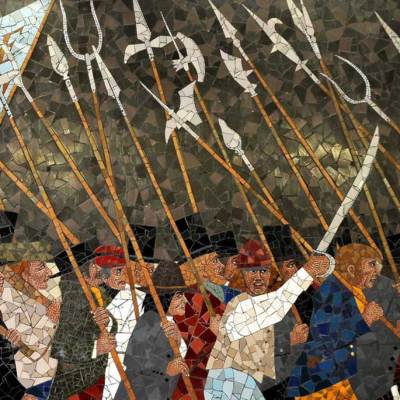A major new show in Calais, France, is just about the most French thing ever. It’s a well-funded art show across, not one, but two regional museums, and the artist – one of the nation’s best known – is a revered contemporary sculptor in her 70s.
So what brings Annette Messager to a troubled port that has been so much in the news for the wrong reasons? France’s commitment to public funding is one answer. But another is Messager’s own biography. The artist was born in Berck-sur-Mer, 60km away, and visited Rodin’s Burghers of Calais as a child. This early exposure to an influential committee surely stood Messager in good stead as she built a career in one of the world’s more bureaucratic art landscapes.
But her Calais show is far from a box-ticking exercise. Most of the work is made especially for the two venues (the Musée des beaux-arts and the Cité de la dentelle et de la mode). Much of it is monumental. And much of it explores the artist’s enduring interest in fashion and textiles. Measuring tape, parachute fabric, lace and imitation leather are just some of the materials to hand. Messager works in a free, spontaneous way, never too serious to incorporate bras, tights, toilet rolls or playful road signage into her installations.
One of the road signs is singled out with a rallying cry from May ’68 – It is forbidden to forbid. It’s a reminder that Messager, who was born in 1943, was just two years out of a Paris art school when that particular revolution nearly kicked off. We can only speculate about the impact of 1968 on the creative imagination of an entire country. London may have been swinging in the 60s, as reflected in the work of Peter Blake or David Hockney. But Paris was briefly on fire.
Messager’s peers will all have felt it one way or another. Her partner, Christian Boltanski, was born in 1944. Both were in their 20s. Daniel Buren (b. 1938) was 30 in the watershed year; Claude Lévêque, Bertrand Lavier and Jean-Marc Bustamante were teenagers. Even French art’s eldest statesman, François Morellet, born in 1926, cannot have been unmoved by the spirit of the times.
These seven artists have become eminent figures in France, the irony being they have thrived in a fairly conservative atmosphere of institutional funding, public commissions and the influential hand of the Ministry of Culture. London may have Frieze, but the French have FRAC (Fonds régionaux d’art contemporain): a government-controlled, regionally-biased collection of some 25,000 artworks by more than 4,000 artists. Think of the Arts Council Collection (which holds just 7,500 works) on steroids.
The art market cannot really take hold here. Places like Calais really don’t need it. That may be why we have no Young French Artists to compare with the likes of Damien Hirst, Tracey Emin or the Chapman brothers. State support on this side of the Channel is a good thing for the regions, but we may wait years for another generation of French talents to compare with Messager and co.
‘Annette Messager: Dessus Dessous’ is at Calais: Musée des beaux-arts & Cité de la dentelle et de la mode until 15 May 2016.



